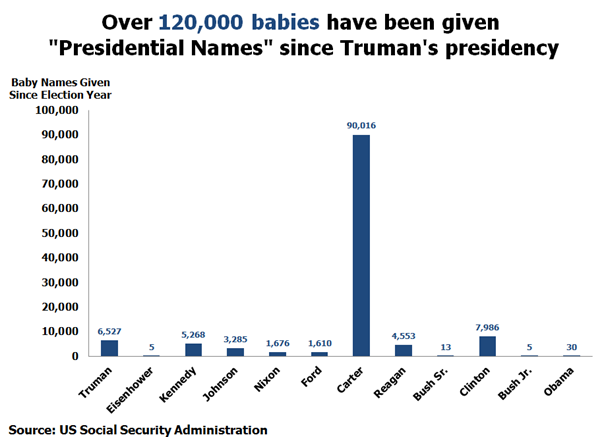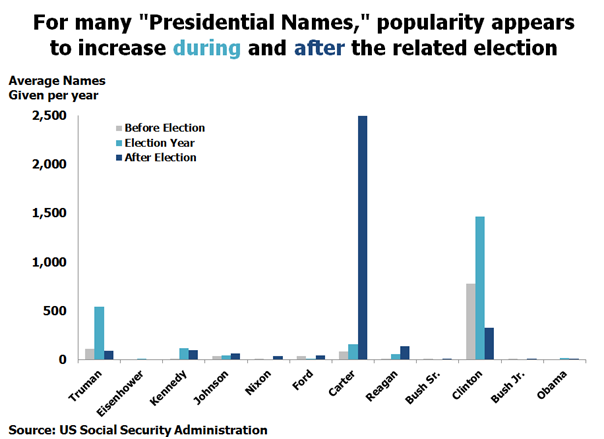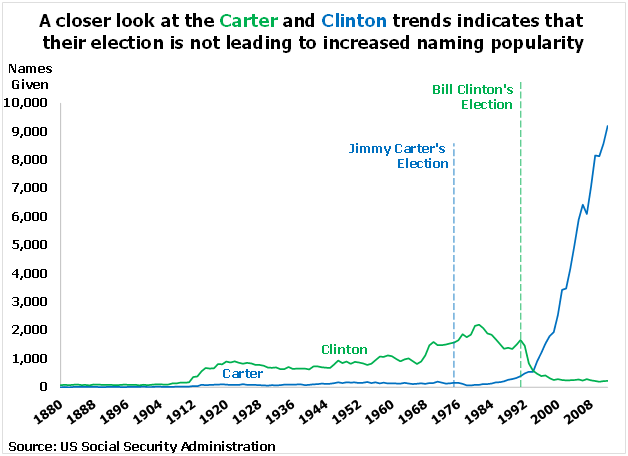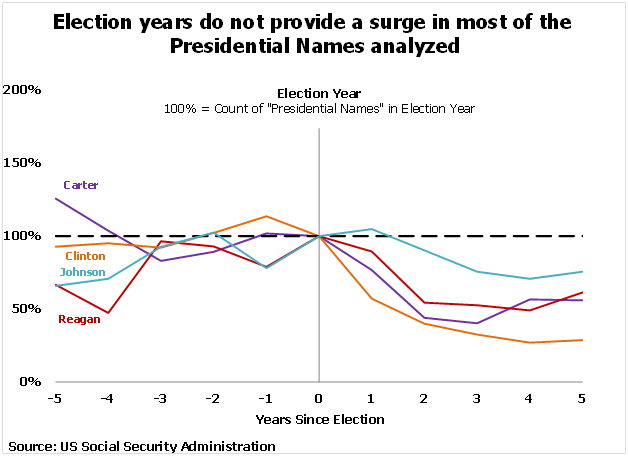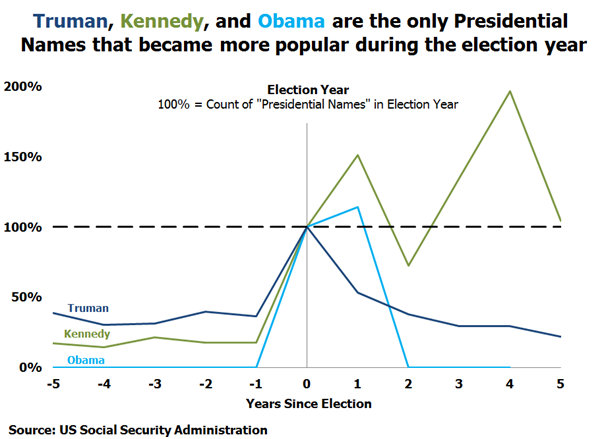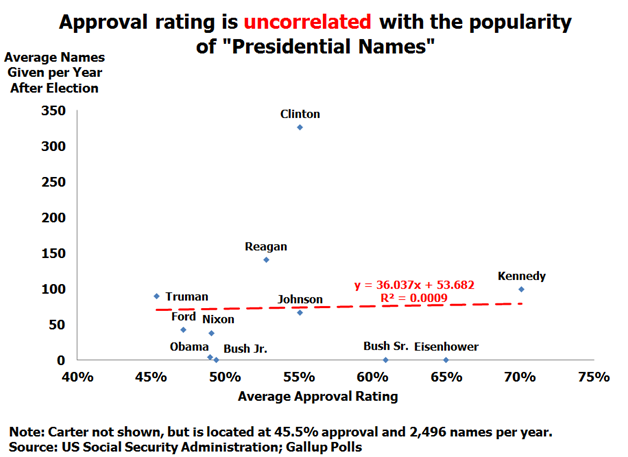September 2013
An event study captures the impact of a certain event(s) on a marketplace. This technique is most commonly used in the context of the stock market, when analysts study the effects of certain events on stock prices. In such an event study, analysts look at share prices prior to the event of interest (e.g. a stock split, CEO resignation, etc.) and compare that prior trend to share prices occurring after the event. It is commonly used in litigation to analyze the financial damage associated with wrongful publicly reported activity, such as measuring the stock price fluctuations associated with a financial restatement. However, the same principles can be applied when analyzing more innocuous events. In this second segment utilizing baby names as a marketplace, we analyze how presidential elections have impacted the popularity of corresponding names.
According to the Social Security Administration (SSA), at least 14 baby boys in the US were named “Obama” in 2008, likely in honor of President Obama’s electoral success in that same year. The world’s youngest Obamas aren’t the first babies to be named in honor of US Presidents. In fact, since Harry Truman’s presidency beginning in 1945, over 120,000 babies have been given “Presidential Names” (i.e. the last name of a current or former President). The chart below shows which Presidential Names are the most popular. Note that the analysis is limited to Presidential Names beginning with Truman, though names like Washington, Jefferson and Jackson likely also enjoy significant popularity.
Carter is by far the most popular of those names considered above, though it is not certain whether this popularity is attributable to Jimmy Carter’s presidency. Without further analysis, we cannot conclusively determine the motivations that parents had in bestowing a Presidential Name upon their child. This uncertainty is especially strong with respect to names that aren’t unique or particular to one of our presidents. “Clinton” for example, had been given as a first name to nearly 87,600 baby boys between 1880 and Bill Clinton’s ascension to executive power in 1992. However, highly unusual first names like Obama and Eisenhower are much more likely to be related to the corresponding president. The chart below shows the average relative popularity of names (i) before the related president’s election, (ii) during the election year, and (iii) after the election.
On this basis, most Presidential names enjoy greater popularity during or after their related election years, suggesting that parents may indeed be naming their children after current or former heads of state. However there is still the suspicion that relatively common names like Carter and Clinton occur independently of the similarly-named presidents and that the cumulative statistics illustrated above obscure actual trends.
An event study allows more insight by providing more detailed timing of activity. This is especially helpful in understanding naming trends for Carter and Clinton, whose popularity would appear related to the election in the above chart, but a time study indicates is not the case:
Further analysis demonstrates that elections do not generally lead to a surge of babies being given Presidential Names. Perhaps the presidential association causes some parents to avoid previously-acceptable names such as Clinton. The chart below, which is limited to a 10 year window surrounding each president’s election, shows the Presidential Names that declined during and after their corresponding elections. Eisenhower, Nixon, and both Bush elections were necessarily eliminated because they had zero Presidential Names during the election period. Ford was also eliminated because its popularity swings wildly, obscuring trends among the other Presidential Names.
Re-scaling the names such that 100% equals the number of President Names in the related election allows easier comparison between Presidential Names. For example, in 1960, 117 boys were named “Kennedy,” which is re-scaled to 100%. In 1964, 230 boys were named Kennedy, resulting in a re-scaled value of 197% (calculated as 230 / 117).
Some names, however, did become more popular around the time of the election, as shown in the chart below:
Although three Presidential Names grew in popularity in the election year, only Kennedy maintained some degree of popularity after the election, possibly due in part to the enduring public fascination with JFK’s life and assassination in 1963.
Differing name utilization patterns could theoretically be explained by the corresponding president’s popularity (as measured by average approval rating). However, the data does not support this theory. If these two variables were positively correlated, the dotted line in the below chart would be upward sloping, i.e. higher approval ratings correspond with increased name popularity. Instead, the line is flat, and the R squared, which measures the degree of correlation on a scale of 0 to 1, is close to zero.
Another possibility is that a few diehard fans are naming their children after presidents, while the majority of people avoid the association with Commanders in Chief. This would explain why relatively popular names like Carter and Clinton become less popular when the association with the president is obvious.
The above charts demonstrate how event studies can illustrate how the public reacts (or fails to react) to a specific event. Identifying and measuring such activity can substantiate (or counter) a claim for economic damages.
Fulcrum Inquiry performs event studies and economic analysis.

